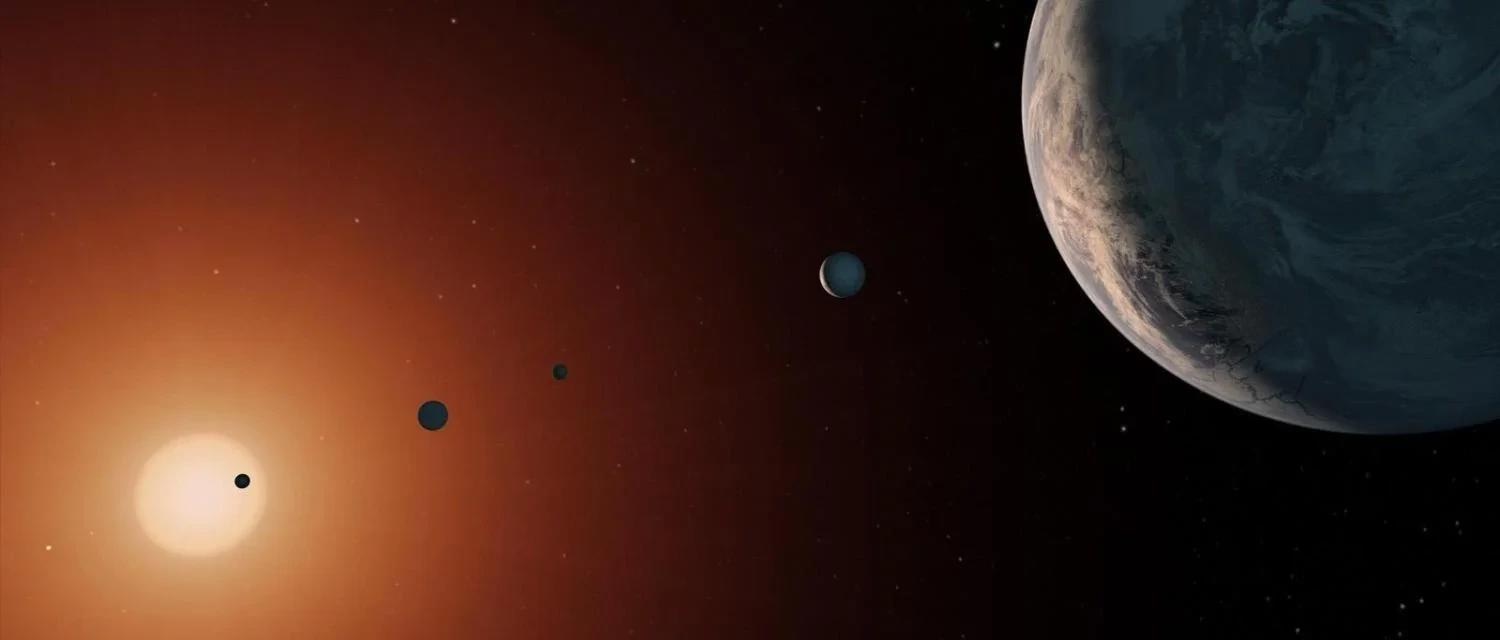Astrophysicists have successfully utilized the James Webb Space Telescope (JWST) to examine a volatile star.

Artist’s depiction of the TRAPPIST-1 system. Image Credit: NASA/JPL-Caltech
In a new study, an international team of researchers conducted a comprehensive assessment of four solar flares flaring from around the star TRAPPIST-1—a tiny and active celestial entity roughly 40 light-years from Earth. The results of this study could help scientists search for faraway planets, or “exoplanets,” that resemble our own and may even support life.
Because of JWST, it is the first time in history that we’ve been able to look for planets around other stars that have the sorts of secondary atmospheres you could find around, say, Earth, Venus or Mars.
Ward Howard, Study Lead Author and NASA Sagan Fellow, Department of Astrophysical and Planetary Sciences, University of Colorado Boulder
That hunt, however, can get a little tricky.
Howard clarified that the majority of the small and rocky celestial bodies scientists intend to explore using the Webb telescope orbit a category of stars known as M-dwarfs, or red dwarfs. These stars are among the most volatile in the galaxy. Take, for example, TRAPPIST-1, which is home to seven confirmed planets.
Despite being just slightly larger than Jupiter, this star emits frequent, powerful flares—intense bursts of energy—that extend far into space several times a day. In comparison, our sun, Earth's star, encounters flares of similar magnitude only approximately once a month.
As a result, viewing a planet around a red dwarf can be a bit like snapping a photo of a friend in a dance club with pulsing lights.
Howard and his colleagues believe they have identified a partial solution in their recent research. The scientists captured a succession of flares erupting from TRAPPIST-1 during a 27-hour period using the Webb telescope, the most sophisticated observatory ever launched into orbit.
The researchers devised a mathematical approach for distinguishing the light emitted by flares from the star’s usual emission. It is similar to applying a filter to a smartphone image to reduce glare.
The end results? Images of planets and their atmospheres might be clearer.
Howard added, “If we want to learn more about exoplanets. It is really important to understand their stars.”
The research findings have been accepted for publication in The Astrophysical Journal and have been made available online ahead of print. These observations, integral to the study, were captured during the telescope's inaugural year of operation by Olivia Lim and David Lafrenière at the University of Montreal, under the umbrella of the NEAT Collaboration initiative.
Precious Planets
Scientists have had their eyes on TRAPPIST-1 for a long time.
Relatively close to Earth in galactic terms, this star proves to be a celestial treasure trove: it accommodates three petite, rocky planets nestled within what scientists term the "habitable zone"—an area around a star where, theoretically, water could exist on a planet's surface.
Astrophysicists are employing the Webb telescope to ascertain whether they can detect any signs of an atmosphere enveloping these planets. (In a recent study spearheaded by Lim, no traces of atmosphere were found around one planet in the system known as TRAPPIST-1 b).
Howard further stated, “There are only a handful of stellar systems where we have the opportunity to look for these sorts of atmospheres. Each one of these planets is truly precious.”
According to Howard, exoplanets like TRAPPIST-1’s seven worlds are so far away that astronomers can only see them as they pass in front of their brilliant stars. But it is challenging when a star is as unstable as TRAPPIST-1.
“If you don’t account for flares, you could detect molecules in the atmosphere that aren’t really there, or get the amount of material in the atmosphere wrong,” Howard added.
Sharper Observations
That's one of the reasons why Howard and his colleagues focused their attention on TRAPPIST-1.
Using the Webb telescope, the researchers observed flares from a distant star in specific wavelengths of infrared light—a type of radiation perfectly suited for the Webb telescope's capabilities. For the first time ever, the team captured the evolution of these four flares in intricate detail, tracking their progression over several hours. The flares grew increasingly brighter, reached their peak intensity, and then gradually dimmed again.
The team was also able to distinguish between the light from TRAPPIST-1’s outbursts and the star’s constant brightness. Using that information, the team was able to filter out around 80% of the flare light from their observations.
Although these numbers are not perfect, Howard pointed out that the team's results will significantly enhance astrophysicists' ability to gather clearer and more precise data about TRAPPIST-1's seven planets. Moreover, the methodology developed could be applied to other similar star systems located near Earth, offering valuable insights into a broader array of celestial phenomena
Howard concluded, “With TRAPPIST-1, we have a really great opportunity to see what an Earth-sized planet around a red dwarf would look like.”
Journal Reference:
Howard, W. S., et al. (2023) Characterizing the Near-infrared Spectra of Flares from TRAPPIST-1 During JWST Transit Spectroscopy Observations. The Astrophysical Journal. doi:10.48550/arXiv.2310.03792